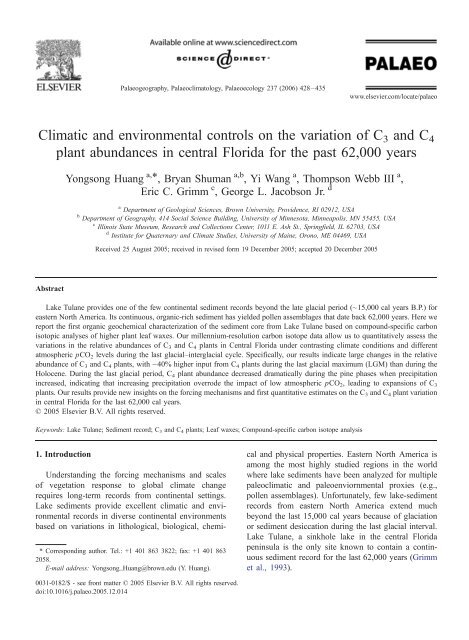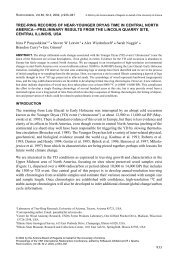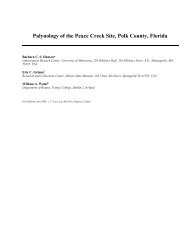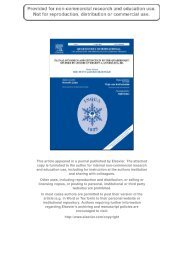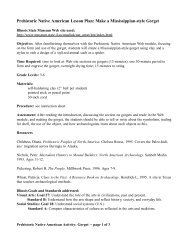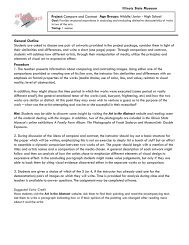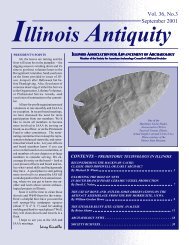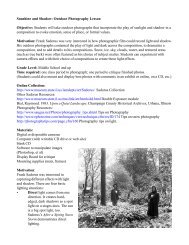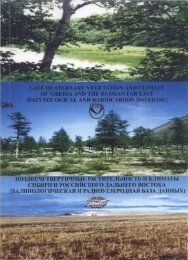2006 Huang et al P3.pdf - Illinois State Museum
2006 Huang et al P3.pdf - Illinois State Museum
2006 Huang et al P3.pdf - Illinois State Museum
Create successful ePaper yourself
Turn your PDF publications into a flip-book with our unique Google optimized e-Paper software.
P<strong>al</strong>aeogeography, P<strong>al</strong>aeoclimatology, P<strong>al</strong>aeoecology 237 (<strong>2006</strong>) 428–435www.elsevier.com/locate/p<strong>al</strong>aeoClimatic and environment<strong>al</strong> controls on the variation of C 3 and C 4plant abundances in centr<strong>al</strong> Florida for the past 62,000 yearsYongsong <strong>Huang</strong> a, *, Bryan Shuman a,b , Yi Wang a , Thompson Webb III a ,Eric C. Grimm c , George L. Jacobson Jr. da Department of Geologic<strong>al</strong> Sciences, Brown University, Providence, RI 02912, USAb Department of Geography, 414 Soci<strong>al</strong> Science Building, University of Minnesota, Minneapolis, MN 55455, USAc <strong>Illinois</strong> <strong>State</strong> <strong>Museum</strong>, Research and Collections Center, 1011 E. Ash St., Springfield, IL 62703, USAd Institute for Quaternary and Climate Studies, University of Maine, Orono, ME 04469, USAReceived 25 August 2005; received in revised form 19 December 2005; accepted 20 December 2005AbstractLake Tulane provides one of the few continent<strong>al</strong> sediment records beyond the late glaci<strong>al</strong> period (~15,000 c<strong>al</strong> years B.P.) foreastern North America. Its continuous, organic-rich sediment has yielded pollen assemblages that date back 62,000 years. Here wereport the first organic geochemic<strong>al</strong> characterization of the sediment core from Lake Tulane based on compound-specific carbonisotopic an<strong>al</strong>yses of higher plant leaf waxes. Our millennium-resolution carbon isotope data <strong>al</strong>low us to quantitatively assess thevariations in the relative abundances of C 3 and C 4 plants in Centr<strong>al</strong> Florida under contrasting climate conditions and differentatmospheric pCO 2 levels during the last glaci<strong>al</strong>–interglaci<strong>al</strong> cycle. Specific<strong>al</strong>ly, our results indicate large changes in the relativeabundance of C 3 and C 4 plants, with ~40% higher input from C 4 plants during the last glaci<strong>al</strong> maximum (LGM) than during theHolocene. During the last glaci<strong>al</strong> period, C 4 plant abundance decreased dramatic<strong>al</strong>ly during the pine phases when precipitationincreased, indicating that increasing precipitation overrode the impact of low atmospheric pCO 2 , leading to expansions of C 3plants. Our results provide new insights on the forcing mechanisms and first quantitative estimates on the C 3 and C 4 plant variationin centr<strong>al</strong> Florida for the last 62,000 c<strong>al</strong> years.D 2005 Elsevier B.V. All rights reserved.Keywords: Lake Tulane; Sediment record; C 3 and C 4 plants; Leaf waxes; Compound-specific carbon isotope an<strong>al</strong>ysis1. Introduction* Corresponding author. Tel.: +1 401 863 3822; fax: +1 401 8632058.E-mail address: Yongsong_<strong>Huang</strong>@brown.edu (Y. <strong>Huang</strong>).Understanding the forcing mechanisms and sc<strong>al</strong>esof veg<strong>et</strong>ation response to glob<strong>al</strong> climate changerequires long-term records from continent<strong>al</strong> s<strong>et</strong>tings.Lake sediments provide excellent climatic and environment<strong>al</strong>records in diverse continent<strong>al</strong> environmentsbased on variations in lithologic<strong>al</strong>, biologic<strong>al</strong>, chemic<strong>al</strong>and physic<strong>al</strong> properties. Eastern North America isamong the most highly studied regions in the worldwhere lake sediments have been an<strong>al</strong>yzed for multiplep<strong>al</strong>eoclimatic and p<strong>al</strong>eoenviornment<strong>al</strong> proxies (e.g.,pollen assemblages). Unfortunately, few lake-sedimentrecords from eastern North America extend muchbeyond the last 15,000 c<strong>al</strong> years because of glaciationor sediment desiccation during the last glaci<strong>al</strong> interv<strong>al</strong>.Lake Tulane, a sinkhole lake in the centr<strong>al</strong> Floridapeninsula is the only site known to contain a continuoussediment record for the last 62,000 years (Grimm<strong>et</strong> <strong>al</strong>., 1993).0031-0182/$ - see front matter D 2005 Elsevier B.V. All rights reserved.doi:10.1016/j.p<strong>al</strong>aeo.2005.12.014
Y. <strong>Huang</strong> <strong>et</strong> <strong>al</strong>. / P<strong>al</strong>aeogeography, P<strong>al</strong>aeoclimatology, P<strong>al</strong>aeoecology 237 (<strong>2006</strong>) 428–435 429High-resolution pollen and macrofossil studies fromLake Tulane reve<strong>al</strong> dramatic changes in veg<strong>et</strong>ation inresponse to climatic and environment<strong>al</strong> changes in Florida(Grimm <strong>et</strong> <strong>al</strong>., 1993). High abundances of Pinus(pine) pollen during the middle to late Holocene areattributed to increased moisture availability, whereashigh abundances of Ambrosia (ragweed), Poaceae(grass), and Quercus (oak) during the last glaci<strong>al</strong> periodresulted from drier climatic conditions. In addition, largeoscillations of Pinus pollen during the last glaci<strong>al</strong> periodappear to correlate with the major Dansgaard–Oeschger(D–O) stadi<strong>al</strong>s that are terminated by Heinrich events inthe North Atlantic. Based on an<strong>al</strong>ysis of pollen andmacrofossil data, Grimm <strong>et</strong> <strong>al</strong>. (1993, in revision) conclud<strong>et</strong>hat the pine phases were w<strong>et</strong>ter and warmer thanthe intervening ragweed–grass–oak phases. Grimm <strong>et</strong> <strong>al</strong>.(in revision) hypothesize that because thermoh<strong>al</strong>ine circulation,which transports heat from the subtropics, wasreduced during cold D–O stadi<strong>al</strong>s and particularly duringHeinrich events, the subtropics warmed when heat transportto the North Atlantic was diminished.Compound-specific carbon-isotope an<strong>al</strong>yses of plantleaf waxes in sediment cores provide more specific dataon the past changes in C 3 and C 4 plant abundances onland than an<strong>al</strong>yzing bulk organic matter which includesinput from both terrestri<strong>al</strong> and aquatic sources (e.g.,Stre<strong>et</strong>-Perrott <strong>et</strong> <strong>al</strong>., 1997; <strong>Huang</strong> <strong>et</strong> <strong>al</strong>., 1999a, 2000,2001; Schefuß <strong>et</strong> <strong>al</strong>., 2003). Changes in the C 3 and C 4plant ratios are affected by climatic and environment<strong>al</strong>factors such as temperature, aridity, and atmosphericpCO 2 levels, <strong>al</strong>though the relative importance of thesefactors is a subject of considerable debate (Cerling <strong>et</strong> <strong>al</strong>.,1997; Pagani <strong>et</strong> <strong>al</strong>., 1999; <strong>Huang</strong> <strong>et</strong> <strong>al</strong>., 2001; Schefuß <strong>et</strong><strong>al</strong>., 2003). Lake Tulane sediment is excellent for observingthe resulting ecologic<strong>al</strong> consequences of low pCO 2and the manner in which these consequences are mediatedby fluctuations from low to high climatic moistureb<strong>al</strong>ance.In particular, the multiple episodes of increasedprecipitation during last glaci<strong>al</strong> period, when pCO 2 wasabout the lowest in the earth history (P<strong>et</strong>it <strong>et</strong> <strong>al</strong>., 1999),provide an excellent opportunity to ev<strong>al</strong>uate the interactionsb<strong>et</strong>ween precipitation and pCO 2 for shaping C 3 /C 4plant ratios.The objectives of this study are: 1) to obtain the first62,000 year record of carbon-isotope records of higherplant biomarkers for eastern North America from LakeTulane sediments; 2) to quantify changes in the relativeabundance of C 3 and C 4 plants around the site, and toassess the impact of precipitation vs. pCO 2 on the C 3 /C 4plant ratios; 3) to provide new insights on the veg<strong>et</strong>ationand climate change in the study region based on isotopicmeasurements on biomarkers in Lake Tulane sediments.2. Samples and experiment<strong>al</strong> m<strong>et</strong>hods2.1. Site and samplesLake Tulane (Latitude 27835V9WN; Longitude81830V13WW; longitude: 81.50361, 117 ft or 36.7 ma.s.l.) lies on the Lake W<strong>al</strong>es Ridge, which is composedof Pliocene beach sands overlying limestone at depth.The Lake W<strong>al</strong>es Ridge rises ~30 m above the surroundinglowlands. The lake is in the <strong>al</strong>luvi<strong>al</strong> aquifer. Sedimentcore (TFG) used in this study is 17 m in length. Atot<strong>al</strong> of 73 samples (each sample is ~1 cm thick, ~1cm 3 volume), were sub-sampled throughout the core at~20 cm interv<strong>al</strong>s. The chronology was established by55 AMS radiocarbon dates on terrestri<strong>al</strong> macrofossilsand bulk sediment (Grimm <strong>et</strong> <strong>al</strong>., in revision). Thesediment is organic rich, with loss-on-ignition N10%,and up to 45%, and contains no carbonate miner<strong>al</strong>s. Thecore is continuous through the last 62,000 c<strong>al</strong> yearsB.P., with no obvious hiatus.Pine and oak leaves were collected from KanapahaBotanic Gardens, in Gainsville, Florida 110 km north ofLake Tulane on Feb. 23, 2003. Leaves were taken fromliving trees with labeled identification and a descriptionof its modern habitats. Slash pine (Pinus elliottii) is thefastest growing southern pine, and common in Floridaand Gulf coast. Longleaf pine (Pinus p<strong>al</strong>ustris) was thedominant pine on the coast<strong>al</strong> plain. Both oaks (Quercushemispherica, Quercus virginiana) are common inFlorida.2.2. Extraction and purificationSediment samples were freeze-dried, and free lipidsextracted using an Accelerated Solvent ExtractorASE200 (Dionex) using 2:1 (v/v) dichlorom<strong>et</strong>hane(DCM):m<strong>et</strong>hanol.Plant leaf samples were firstcleaned with clean water to remove dust particles,freeze-dried, and then rinsed with DCM three timesto obtain extracts of leaf waxes. Carboxylic acidfraction is isolated from the tot<strong>al</strong> extracts usingsolid phase extraction (Aminopropyl Bond EluteR),and is then m<strong>et</strong>hylated using anhydrous 2% HCl inM<strong>et</strong>hanol. M<strong>et</strong>hylated carboxylic acid fractions werefurther purified using a silica gel flash column chromtographywith DCM as the eluant (removes hydroxylcarboxylicacids). Aliphatic hydrocarbons wereobtained by eluting the neutr<strong>al</strong> fractions with hexane.Some <strong>al</strong>kenes were present in the <strong>al</strong>iphatic hydrocarbonfractions, which were removed by RuO 4 oxidationfollowed by a silica gel chromatograhpy (<strong>Huang</strong><strong>et</strong> <strong>al</strong>., 1999b).
430Y. <strong>Huang</strong> <strong>et</strong> <strong>al</strong>. / P<strong>al</strong>aeogeography, P<strong>al</strong>aeoclimatology, P<strong>al</strong>aeoecology 237 (<strong>2006</strong>) 428–4352.3. Gas chromatographyHydrocarbons and fatty acid fractions were first an<strong>al</strong>yzedusing an Hewl<strong>et</strong>t-Packard 6890 gas chromatograph,fitted with a 60 m fused silica column (HP-1 MS, 0.32 mmi.d., 0.25 Am film thickness), a flame ionization d<strong>et</strong>ector,a split/splitless injector (operated at a split ratio of 10:1),and an HP7683 auto-sampler. Helium was used as thecarrier gas, with a flow rate of 1.7 ml min 1 . Th<strong>et</strong>emperature program was isotherm<strong>al</strong> at 40 8C for 1min, followed by heating to 300 8C at108C min 1 .2.4. Compound-specific carbon-isotope an<strong>al</strong>ysisCarbon-isotope an<strong>al</strong>yses of higher plant biomarkerswere performed using a gas chromatograph-combustionisotoperatio mass spectrom<strong>et</strong>er (GC-C-IRMS, ThermoFinnigan). An HP 6890 GC, equipped with an AS 200auto-sampler, was connected to a Finnigan MAT Delta + -XL mass spectrom<strong>et</strong>er via the combustion interface. Th<strong>et</strong>emperature program and capillary column used wereidentic<strong>al</strong> to those used for GC an<strong>al</strong>ysis. Helium (UHP 5.5grade) was used as the carrier gas operating at constantflow mode with a rate of 1.5 ml/min. Compounds separatedby the GC column were converted to CO 2 andH 2 O through the combustion furnace (0.5 mm i.d.1.5 mm o.d.34 cm) operated at 940 8C and loadedwith CuO and Pt wires as oxidants and cat<strong>al</strong>yst, respectively.Six pulses of CO 2 reference gas with known d 13 Cv<strong>al</strong>ues were injected via the interface to the IRMS, for thecomputation of sample d 13 C v<strong>al</strong>ues. Typic<strong>al</strong> standarddeviation of duplicate an<strong>al</strong>yses is about. F0.2–0.3x.For n-fatty acids, the added carbon as a result of derivatizationhas been corrected for its carbon isotopic contributionto the fatty acid m<strong>et</strong>hyl esters (<strong>Huang</strong> <strong>et</strong> <strong>al</strong>.,1999a). V<strong>al</strong>ues of d 13 C are reported in the usu<strong>al</strong> dnotation relative to the Vienna Pee Dee Belemnite(VPDB) standard.3. ResultsWe d<strong>et</strong>ermined the carbon isotope ratios of individu<strong>al</strong>long chain n-<strong>al</strong>kanes (C 27 ,C 29 and C 31 , tot<strong>al</strong> 61 samples)and n-fatty acids (C 26 ,C 28 and C 30 , tot<strong>al</strong> 72 samples)extracted from the Tulane sediment core at approximatelymillenni<strong>al</strong> resolution for the last 62,000 years. Theselong carbon chain compounds are leaf waxes producedby land plants (Eglinton and Hamilton, 1967). The differencein the number of samples an<strong>al</strong>yzed for n-<strong>al</strong>kanesand n-acids resulted from low concentrations and/orcompound coelutions in some of the samples an<strong>al</strong>yzed.Fatty acids are gener<strong>al</strong>ly more abundant than <strong>al</strong>kanes,and were an<strong>al</strong>yzed in more samples. The carbon-isotopev<strong>al</strong>ues of C 27 ,C 29 and C 31 n-<strong>al</strong>kanes and C 26 ,C 28 andC 30 n-fatty acids show gener<strong>al</strong>ly par<strong>al</strong>lel downcore variationsand are plotted <strong>al</strong>ong with pollen and loss-onignitiondata in Fig. 1. The data are plotted againstsample age in Fig. 2, <strong>al</strong>ong with factor 1 scores ofFig. 1. Carbon isotope ratios of individu<strong>al</strong> long chain leaf wax n-<strong>al</strong>kanes and n-acids, plotted against depth (including water depth), <strong>al</strong>ong withpercentage pine, oak and ragweed pollen, as well as loss-on-ignition.
432Y. <strong>Huang</strong> <strong>et</strong> <strong>al</strong>. / P<strong>al</strong>aeogeography, P<strong>al</strong>aeoclimatology, P<strong>al</strong>aeoecology 237 (<strong>2006</strong>) 428–435and C 4 plants have non-overlapping d 13 C v<strong>al</strong>ues(C 4 ~ 20x, C 3 ~ 33x, assuming bulk d 13 C v<strong>al</strong>uesof 10x and 27x for C 4 and C 3 plants, respectively)and can be used to reconstruct past changes in the relativeabundance of C 3 and C 4 plants from lake and marinesediment cores (<strong>Huang</strong> <strong>et</strong> <strong>al</strong>., 1999b, 2000, 2001;Schefuß <strong>et</strong> <strong>al</strong>., 2003).d 13 C v<strong>al</strong>ues of evergreen trees have <strong>al</strong>so beenreported to have higher d 13 C v<strong>al</strong>ues than the co-occurringdeciduous trees (both are C 3 plants). In a study ofplant samples collected over 2 years, Brooks <strong>et</strong> <strong>al</strong>. (1997)show that d 13 C v<strong>al</strong>ues of evergreen trees were 3–4xhigher than deciduous trees. Similarly, 2–4x highercarbon-isotope discrimination occurs in oak (Quercusgambelii) than in pine (Pinus edulis) (Williams andEhleringer, 1996). Stuiver and Braziunas (1987) showthat d 13 C v<strong>al</strong>ues of wood in gymnosperm trees are~3x higher than those in angiosperm trees. Leaf waxn-<strong>al</strong>kanes from angiosperms have d 13 C v<strong>al</strong>ues of36.1F2.7x, 4.5x lower than those of gymnosperms( 31.6F1.7x) (Chikaraishi and Naraoka, 2003). Nopublished data exist for the carbon isotopic compositionsof leaf waxes from pine and oak trees in Florida. W<strong>et</strong>herefore collected two pine-leaf and two oak-leaf samples(<strong>al</strong>l common in Florida) from Kanapaha BotanicGarden in Gainsville, Florida, ~110 km north of LakeTulane. The carbon isotopic v<strong>al</strong>ues of leaf waxes of bothspecies of pine are on average 4–5x higher than the oaktrees (Table 1). We take this isotopic difference intoconsideration in our subsequent discussions.4.2. Quantitative estimates of C 3 and C 4 plant changesin Centr<strong>al</strong> FloridaCarbon-isotope ratios of leaf waxes can be used toquantitatively reconstruct the percentage changes in C 3Table 1Carbon isotope compositions (x VPDB) of individu<strong>al</strong> leaf waxes inpine and oak samples from FloridaLongleafpineSlashpineQuercushemisphericaQuercusvirginiansn-AlkanesC 27 31.4 31.3 40.4 36.9C 29 29.2 30.1 40.2 37.5C 31 29.3 30.3 36.7 35.5Mean 30.0 30.6 39.1 36.6n-AcidsC 26 29.6 29.9 32.8 32.7C 28 29.7 32.7 37.9 34.3C 30 29.8 31.2 37.1 34.2Mean 29.7 31.3 35.9 33.7and C 4 plants from ocean and lake sediments (<strong>Huang</strong><strong>et</strong> <strong>al</strong>., 1999b, 2000, 2001; Schefuß <strong>et</strong> <strong>al</strong>., 2003). Becauselong chain leaf waxes in lake sediments areunambiguously derived from land plants (both C 3and C 4 plants), but not <strong>al</strong>gae and submerged aquaticorganisms, an<strong>al</strong>ysis of d 13 C v<strong>al</strong>ues of leaf waxes eliminatesthe uncertainty of terrestri<strong>al</strong> and aquatic sourcesthat exists in the an<strong>al</strong>ysis of bulk-sediment d 13 Cv<strong>al</strong>ues. Endmember v<strong>al</strong>ues for C 3 and C 4 plants canbe based on gener<strong>al</strong> v<strong>al</strong>ues for C 3 and C 4 plants, orthey can be based on the extreme carbon-isotopev<strong>al</strong>ues in the sediment core if the extreme v<strong>al</strong>uesexceed the range of commonly assumed v<strong>al</strong>ues (Collister<strong>et</strong> <strong>al</strong>., 1994). In the case of Lake Tulane, however,three endmembers must be assigned because carbonisotoperatios of pines are different from oaks, despiteboth being C 3 plants. In order to quantitatively estimat<strong>et</strong>he changes in C 3 and C 4 plants from Tulane, weuse the following equations:d p F p þ d C3 F C3 F pþ dC4 ¼ d m ð1ÞF C3 þ F p þ F C4 ¼ 1F p ¼ Fine pollen fractionð2Þð3Þwhere F C3 and F C4 are estimated C 3 and C 4 plantabundance (expressed in fractions). F p is the fractionof pine as a speci<strong>al</strong> category of C 3 plants and is takento be equiv<strong>al</strong>ent to the pine-pollen fractions in order toprovide enough equations to solve for the F C3 andF C4 . d p , d C3 and d C4 are endmember d 13 C v<strong>al</strong>ues forleaf waxes of pine, C 3 (excluding pine, including oakand other C 3 trees and grasses), and C 4 plants, respectively.d m is the measured d 13 C v<strong>al</strong>ue of leaf waxesdowncore. We choose two endmember s<strong>et</strong>s to test thesensitivity of the model: a) d C4 = 20x, d p = 33xand d C3 = 38x; and b) d C4 = 23x, d p = 33x andd C3 = 39x. The C 4 plant fraction is thenaÞ F C4 ¼ d m þ 38 5F p=18 ð4ÞbÞ F 4 ¼ d m þ 39 64F p=16: ð5ÞBecause the d 13 C trend in individu<strong>al</strong> leaf waxes isgener<strong>al</strong>ly similar (Figs. 1 and 2), we used the d 13 Cv<strong>al</strong>ue of C 28 n-acid as the input v<strong>al</strong>ue for d m , andcomputed the F C4 for the last 62,000 years (Figs. 3and 4). Our results indicate the highest fraction of C 4plant input was at LGM (~0.4). The fraction is relativelysm<strong>al</strong>l and stable during the Holocene, with a
Y. <strong>Huang</strong> <strong>et</strong> <strong>al</strong>. / P<strong>al</strong>aeogeography, P<strong>al</strong>aeoclimatology, P<strong>al</strong>aeoecology 237 (<strong>2006</strong>) 428–435 433Fig. 3. Comparisons of computed percentage input from C 4 plants to the lake, Pine and Ambrosia-type pollen, PCA factor 1 scores and pCO 2 level.sm<strong>al</strong>l increase towards recent times. Changes in endmemberd 13 C v<strong>al</strong>ues resulted in little change in therelative percentage of C 3 and C 4 estimates (Fig. 4). Itis interesting to note that changes in the C 3 and C 4plants during the Holocene are sm<strong>al</strong>l despite the ~5xshift in d 13 C v<strong>al</strong>ues of leaf waxes (Figs. 2 and 3). Ourresults indicate that the Holocene carbon isotopic shiftis primarily a result of changes in the relative abundanceof pine and oak, rather than changes in C 3 and C 4plant abundances.Fig. 4. Computed percentage input from C 4 plants with two different isotopic endmember assumptions.
434Y. <strong>Huang</strong> <strong>et</strong> <strong>al</strong>. / P<strong>al</strong>aeogeography, P<strong>al</strong>aeoclimatology, P<strong>al</strong>aeoecology 237 (<strong>2006</strong>) 428–4354.3. Veg<strong>et</strong>ation change and forcing mechanismThe relative importance of climatic (precipitation,temperature) and atmospheric ( pCO 2 ) conditions onthe natur<strong>al</strong> abundance of C 4 and C 3 plants is an importanttopic in earth system history and is widely debated(Cerling <strong>et</strong> <strong>al</strong>., 1997; Pagani <strong>et</strong> <strong>al</strong>., 1999; <strong>Huang</strong> <strong>et</strong> <strong>al</strong>.,2001; Schefuß <strong>et</strong> <strong>al</strong>., 2003). Because C 4 plants possessa CO 2 concentrating mechanism and have very lowlevel (2% to 5% of those in C 3 plants) of photorespiratoryinhibitation of photosynthesis (von Caemmerer andFurbank, 1982), they have an important advantage overC 3 plants at times of low pCO 2 /O 2 ratios in earthhistory (Sage <strong>et</strong> <strong>al</strong>., 1999). A widespread expansion ofC 4 plants in the late Miocene may be primarily a resultof significant reduction of atmospheric pCO 2 levels(Cerling <strong>et</strong> <strong>al</strong>., 1997). Because the physiologic<strong>al</strong>mechanisms that provide an advantage to C 4 plantsunder low pCO 2 to mitigate moisture loss, aridity is<strong>al</strong>so an important factor in controlling the relative ratiosof C 3 /C 4 plants and the region<strong>al</strong> timing of C 4 expansion(Pagani <strong>et</strong> <strong>al</strong>., 1999; <strong>Huang</strong> <strong>et</strong> <strong>al</strong>., 2001; Schefuß <strong>et</strong> <strong>al</strong>.,2003). C 3 plants can increase in abundance relative toC 4 plants at low atmospheric pCO 2 levels of the lastglaci<strong>al</strong> period if precipitation is sufficiently high(Schefuß <strong>et</strong> <strong>al</strong>., 2003). Conversely, low pCO 2 levelscan prohibit C 3 success under the precipitation levelsthat they tolerate today (Cowling and Sykes, 1999), andchange the plant water use efficiencies (Polley <strong>et</strong> <strong>al</strong>.,1993). The sensitivity of C 3 and C 4 plants towardenvironment<strong>al</strong> factors likely differs in different natur<strong>al</strong>ecosystems. Lake Tulane offers a unique opportunity tofurther understand the dynamics of C 3 and C 4 plants inthe natur<strong>al</strong> ecosystem of eastern North America.The d 13 C v<strong>al</strong>ues of leaf waxes were the highest( 28x to 30x) during the LGM. The minimumd 13 C v<strong>al</strong>ues ( 39x to 40x) were reached in theearly Holocene 10,000–9000 c<strong>al</strong> years B.P. The resultssupport higher abundances of C 4 plants in the LGMwhen climate was significant drier (based on bothpollen data) and atmospheric pCO 2 was ~30% lower.Large oscillations of C 4 fractions occurred during thePleistocene, with relatively high C 4 fractions interruptingpine expansions (Fig. 4). The estimated fraction ofC 3 plants nearly reached the Holocene levels when pineexpanded and precipitation increased. Because pCO 2 isgener<strong>al</strong>ly low during the early part of the record, ourdata indicate that precipitation plays an essenti<strong>al</strong> role inmodulating the natur<strong>al</strong> abundance of C 3 and C 4 plantsin centr<strong>al</strong> Florida (i.e., more important than pCO 2 ).Based on species numbers, 63–80% of moderngrasses in Florida use C 4 photosynth<strong>et</strong>ic pathway(Sage <strong>et</strong> <strong>al</strong>., 1999). The low d 13 C v<strong>al</strong>ues of leafwaxes during the early Holocene indicate a relativelysm<strong>al</strong>l fraction of C 4 plants, contrasting with an increasein the grass pollen (Figs. 1 and 2). Although a higherratio of C 3 to C 4 grasses during the early Holocenewould explain the d 13 C v<strong>al</strong>ues, it is unlikely that C 3grasses were dominant members of the upland veg<strong>et</strong>ationin Florida. Given the low percentages of Ambrosiaand other herb pollen during the early Holocene, thed 13 C v<strong>al</strong>ues may indicate that high grass pollen percentagesderive from loc<strong>al</strong> emergent or damp–groundgrasses growing near the lake. Thus, the d 13 C v<strong>al</strong>uesmay help to confirm that the presence of closed woodlands(rather than oak–grass savannas) on the uplandduring the early Holocene.5. ConclusionsWe have obtained a 62,000 year record of changes inthe relative abundance of C 3 and C 4 plants from LakeTulane, Centr<strong>al</strong> Florida. The record is so far the longestcontinent<strong>al</strong> veg<strong>et</strong>ation and isotopic record for easternNorth America. Carbon-isotope data of individu<strong>al</strong> leafwaxes from Lake Tulane sediments indicate substanti<strong>al</strong>lymore abundant C 4 plants during LGM than the Holocene,as a result of the physiologic<strong>al</strong>ly drier conditionsand lower atmospheric pCO 2 level. Leaf waxes of pinehave a few per mil higher d 13 C v<strong>al</strong>ues than other C 3angiosperms, leading to the ~4–5x positive carbonisotopic excursion from the early Holocene to the present.By using pine pollen fraction as an added inputparam<strong>et</strong>er, a quantitative estimate on the input of C 3and C 4 plant leaf waxes to the lake sediments can bemade, taking into consideration of different d 13 C v<strong>al</strong>uesof evergreen and deciduous trees. Large decreases in C 4plants during Pleistocene pine phases (and correspondingincreases in C 3 plants to near Holocene levels)suggest that precipitation increases counteracted thephysiologic<strong>al</strong> advantage of C 4 over C 3 plants in centr<strong>al</strong>Florida even when pCO 2 was at its minimum level inrecent earth history. Therefore, the importance of precipitationon the natur<strong>al</strong> b<strong>al</strong>ance of C 3 and C 4 plant must becarefully considered in veg<strong>et</strong>ation models.AcknowledgementsFunds from the Earth System History Program at theNation<strong>al</strong> Science Foundation supported this researchthough grants to Y. <strong>Huang</strong> (NSF-0081478, 0318050,0318123, 0402383), E.C. Grimm (ATM-9405145) andG.L. Jacobson (ATM-9321265). The pollen data areavailable from the North American Pollen Database at
Y. <strong>Huang</strong> <strong>et</strong> <strong>al</strong>. / P<strong>al</strong>aeogeography, P<strong>al</strong>aeoclimatology, P<strong>al</strong>aeoecology 237 (<strong>2006</strong>) 428–435 435the World Data Center for P<strong>al</strong>eoclimatology: http://www.ncdc.noaa.gov/p<strong>al</strong>eo/data.html.ReferencesBrooks, J.R., Flanagan, L.B., Buchmann, N., Ehleringer, J.R., 1997.Carbon isotope composition of bore<strong>al</strong> plants: function<strong>al</strong> groupingof life forms. Oecologia 110, 301–311.Cerling, T.E., Wang, Y., Quade, J., 1997. Expansion of C 4 ecosystemsas an indicator of glob<strong>al</strong> ecologic<strong>al</strong> change in the late Miocene.Nature 361, 344–345.Chikaraishi, Y., Naraoka, H., 2003. Compound-specific dD–d 13 Can<strong>al</strong>yses of n-<strong>al</strong>kanes extracted from terrestri<strong>al</strong> and aquatic plants.Phytochemistry 63, 361–371.Collister, J.W., Rieley, G., Stern, B., Eglinton, G., Fry, B., 1994.Compound-specific d 13 C an<strong>al</strong>yses of leaf lipids from plantswith differing carbon dioxide m<strong>et</strong>abolisms. Org. Geochem. 21,619–627.Cowling, S.A., Sykes, M.T., 1999. Physiologic<strong>al</strong> significance of lowatmospheric CO 2 for plant–climate interactions. Quat. Res. 52,237–242.Eglinton, G., Hamilton, R.J., 1967. Leaf epicuticular waxes. Science156, 1322–1334.Grimm, E.C., Jacobson, G.L., Watts, W.A., Hansen, B.C., Maasch,K.A., 1993. A 50,000-year record of climate oscillations fromFlorida and its tempor<strong>al</strong> correlation with Heinrich events. Science261, 198–200.Grimm, E.C., Watts, W.A., Jacobson, Jr. G.L., Hansen, B.C.S., Almquist,H., Dieffenbacher-Kr<strong>al</strong>l, A.C. Warm w<strong>et</strong> Heinrich events inFlorida. Quaternary Science Reviews, in revision.Grootes, P.M., Stuiver, M., White, J.W.C., Johnsen, S.J., 1993. Comparisonof oxygen isotope records from the GISP2 and GRIPGreenland ice cores. Nature 366, 552–554.<strong>Huang</strong>, Y., Stre<strong>et</strong>-Perrott, F.A., Perrott, F.A., M<strong>et</strong>zger, P., Eglinton, G.,1999a. Glaci<strong>al</strong>–interglaci<strong>al</strong> environment<strong>al</strong> changes inferred fromthe molecular and compound-specific d 13 C an<strong>al</strong>yses of sedimentsfrom Sacred Lake, Mt. Kenya. Geochim. Cosmochim. Acta 63,1383–1404.<strong>Huang</strong>, Y., Li, B., Bryant, C., Bol, R., Eglinton, G., 1999b. Radiocarbondating of <strong>al</strong>iphatic hydrocarbons: a new approach fordating the passive fraction carbon in soil horizons. Soil Sci.Soc. Am. J. 63, 1181–1187.<strong>Huang</strong>, Y., Dupont, L., Sarnthein, M., Hayes, J.M., Eglinton, G.,2000. Mapping of C 4 plant input from North West Africa intothe North East Atlantic sediments. Geochim. Cosmochim. Acta64, 3505–3513.<strong>Huang</strong>, Y., Stre<strong>et</strong>-Perrott, F.A., M<strong>et</strong>c<strong>al</strong>fe, S.E., Brenner, M., Moreland,M., Freeman, K.H., 2001. Climate change as the dominantcontrol on glaci<strong>al</strong>–interglaci<strong>al</strong> variations in C 3 and C 4 plant abundance.Science 293, 1647–1651.Pagani, M., Freeman, K.H., Arthur, M.A., 1999. Late Miocene atmosphericCO 2 concentrations and the expansion of C 4 grasses.Science 285, 876.P<strong>et</strong>it, J.R., Jouzel, J., Raynaud, D., Barkov, N., Barnola, I., Basile, J.-M., Bender, I., Chappellaz, M., Davisk, J., Delaygue, M., Delmotte,G., Kotlyakov, M., Legrand, M., Lipenkov, M., Lorius, Y.,Pépin, C., Ritz, L., S<strong>al</strong>tzmank, C., Stievenard, E., 1999. Climateand Atmospheric History of the Past 420,000 years from theVostok Ice Core, Antarctica. Nature 399, 429–436.Polley, H.W., Johnson, H.B., Marino, B.D., Mayeux, H.S., 1993.Increase in C 3 plant water-use efficiency and biomass over glaci<strong>al</strong>to present CO 2 concentrations. Nature 361, 61–64.Rieley, G., Collister, J.W., Stern, B., Eglinton, G., 1993. Gas chromagraphy/isotoperatio mass spectrom<strong>et</strong>ry of leaf wax n-<strong>al</strong>kanesfrom plants of differing carbon dioxide m<strong>et</strong>abolism. Rapid Commun.Mass Spectrom. 7, 488–491.Sage, R.F., Wedin, D.A., Li, M., 1999. The biogeography of C 4photosynthesis: patterns and controlling factors. In: Sage, R.F.,Monson, R.K. (Eds.), C 4 Plant Biology. Academic Press, SanDiego, pp. 313–373.Schefuß, E., Schouten, S., Jansen, J.H.F., Sinninghe Damsté, J.S.,2003. Africa veg<strong>et</strong>ation controlled by tropic<strong>al</strong> sea surface temperaturesin the mid-Pleistocene period. Nature 422, 418–421.Stre<strong>et</strong>-Perrott, F.A., <strong>Huang</strong>, Y., Perrott, A., Eglinton, G., Baker, P.,Khelifa, L., Harkness, D.D., Olago, D., 1997. The impact of loweratmospheric CO 2 on tropic<strong>al</strong> mountain ecosystems. Science 278,1422–1426.Stuiver, M., Braziunas, T.F., 1987. Tree cellulose 13 C/ 12 C isotoperatios and climate change. Nature 328, 58–60.Von Caemmerer, S., Furbank, R.T., 1982. Modeling C 4 photosynthesis.In: Sage, R.F., Monson, R.K. (Eds.), C 4 Plant Biology.Academic Press, San Diego, pp. 173–211.Williams, D.G., Ehleringer, J.R., 1996. Carbon isotope discriminationin three semi-arid woodland species <strong>al</strong>ong a monsoon gradient.Oecologia 106, 455–460.


